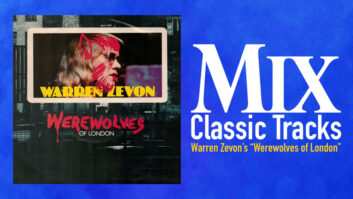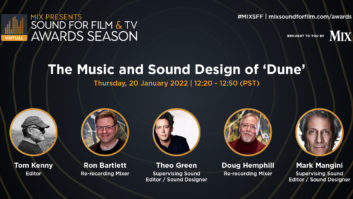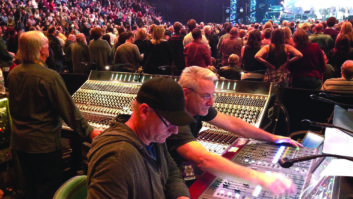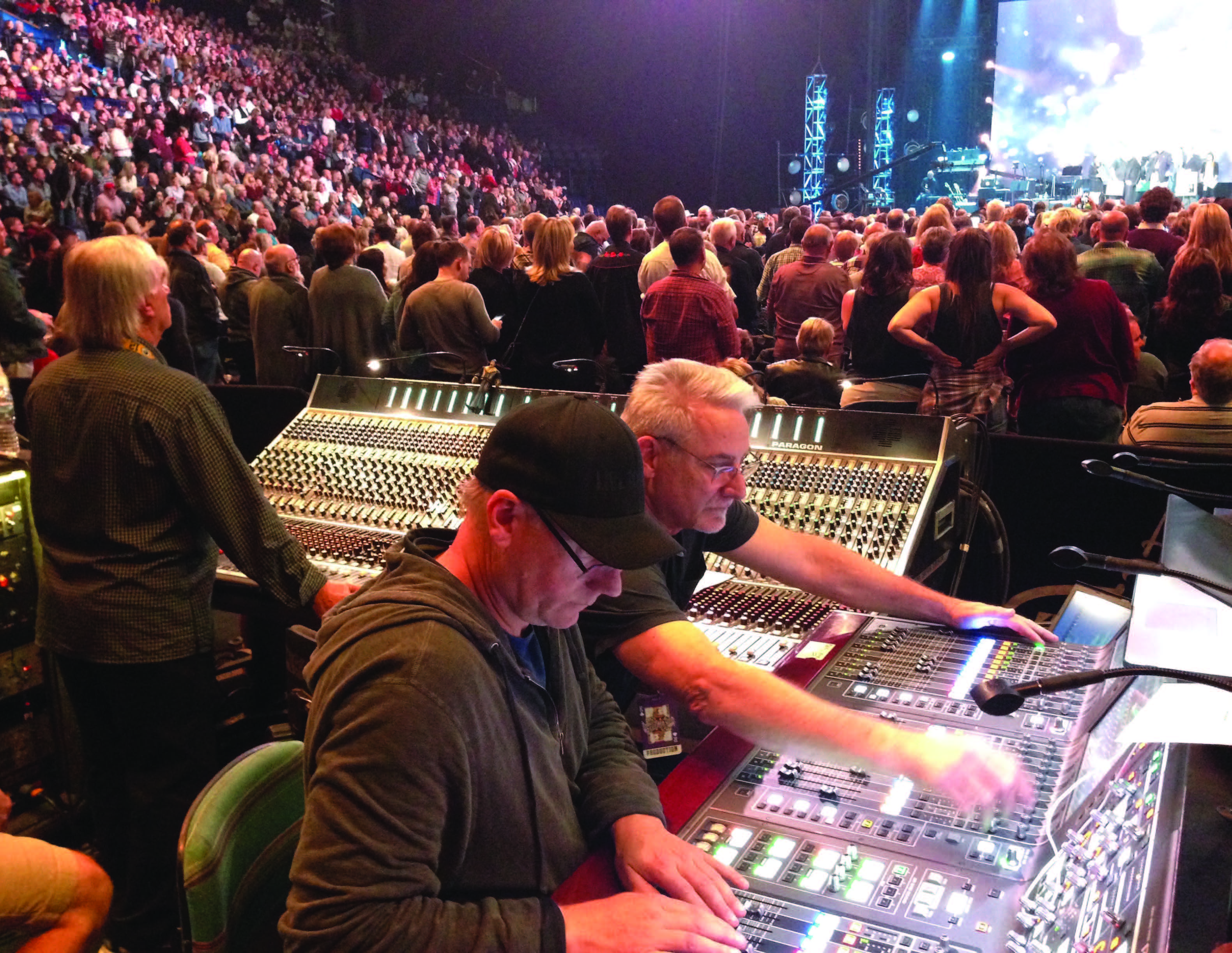
How can you begin to describe the career of an entertainer who has performed for 60 years, sold more than 100 million records worldwide, is a member of the Country Music Hall of Fame, and by all accounts is beloved in the music community? “Stellar” comes to mind, and Kenny Rogers’ peers would agree.
In honor of Rogers’ announced retirement plans, they staged “All In for the Gambler: Kenny Rogers’ Farewell Concert Celebration” on October 25 at the Bridgestone Arena in Nashville. Featuring performances from Don Henley, Little Big Town, Alison Krauss, Lionel Richie, Chris Stapleton, Lady Antebellum, Kris Kristofferson and others, the concert ended with Rogers performing duets with Dolly Parton.
Called in to manage front of house for the event were engineers John McBride, Rogers’ longtime FOH engineer Keith Bugos, and Joe Keiser. “When they called me to do front of house and I saw the lineup of talent,” begins McBride, “it made me realize that it was going to be a memory I wanted to be a part of. After I had committed to doing it I spoke with Keith, and he offered to come in and help out. I’ve known Keith for years, and no one knows those songs better than he does. It’s in his DNA, so it made a lot of sense for us to work together. To be honest it was great to just hang out with him.”
Don Was served as the Musical Director, forming a backup band that featured himself on bass, Kenny Aronoff on drums, Matt Rollings on keys, and Jedd Hughes and Tom Bukovac on guitar. That band would accompany all of the guest artists, sometimes augmented by guest instrumentalists. Most of the inputs for the backup band were routed to McBride’s ATI Paragaon (analog) mixing console. “We used the Paragon for inputs from the band and some of the vocals, and a Yamaha Rivage PM10 for vocals and guest instruments,” explains McBride. “It was a great band, so making them sound great was pretty easy.”
Keiser formulated a plan for combining audio from the PM10 (which he uses to mix Nickelback) and the Paragon, and routing feeds to the main FOH system, as well as additional output feeds. “At rehearsals,” Keiser says, “we thought about whether we should route the Paragon into the PM10, or vice versa. Initially we patched the Paragon into the PM10 and then the PM10 fed the P.A. system. When we got into the Bridgestone Arena for rehearsal on the day of the show, John’s full drive rack was there with all his high-end vintage gear. He wanted to use that gear, so we went from the PM10 into John’s drive rack, then into Lake LM44s to drive the entire P.A. system.”
The P.A, consisted of four hangs of Clair Cohesion CO-12 cabinets. The main hangs had 16 cabinets per side, while smaller side hangs of 12 CO-8 cabinets were placed approximately eight feet upstage. The arrays were supplemented with Clair CP-218 subwoofers.
“We had six subs per side,” says Keiser, “and believe it or not, we never turned them on. The CO-12 has such a natural, solid low end that we didn’t need to augment their low-frequency response. During rehearsal we pulled up the drums at FOH, and when I told John the subs weren’t on he started laughing. We had already done a few bands without the subs, so we just left them off!”
A hockey game was scheduled at the Bridgestone the night before the performance, explains McBride, so rehearsals were in a separate location and they didn’t get into Bridgestone until 5 a.m. on show day. With 25 guest artists, there was a lot to prepare for. Keiser programmed scenes on the PM10 as they built the show, allowing recall of settings for specific artists.
“Every artist had their own spin on Kenny’s songs,” states Keith Bugos, who has been Rogers’ FOH engineer since the early 1980s. “The producers of the show did a great job of matching each song to the guest artist. When someone is doing their interpretation of the song, you have to allow them the freedom to express their vision, but obviously the vocal qualities of each artist were very different. You have to make sure that you represent them accurately while being true to the song.”
“Using the PM10 for the vocals helped us quite a bit in that regard,” Keiser adds. “Typically, you mix a band with the same singer all night, so you might use the EQ on the channel as well as the EQ on the L/R bus to tailor the P.A. to their voice. In this case we had the same band with different singers for each song—and that presents a challenge in regards to the system EQ. I tried changing the system EQ on the PM10 to accommodate different singers, but that didn’t work very well because it changed the sound of the band; the band sounded so good that you don’t want to mess with that.
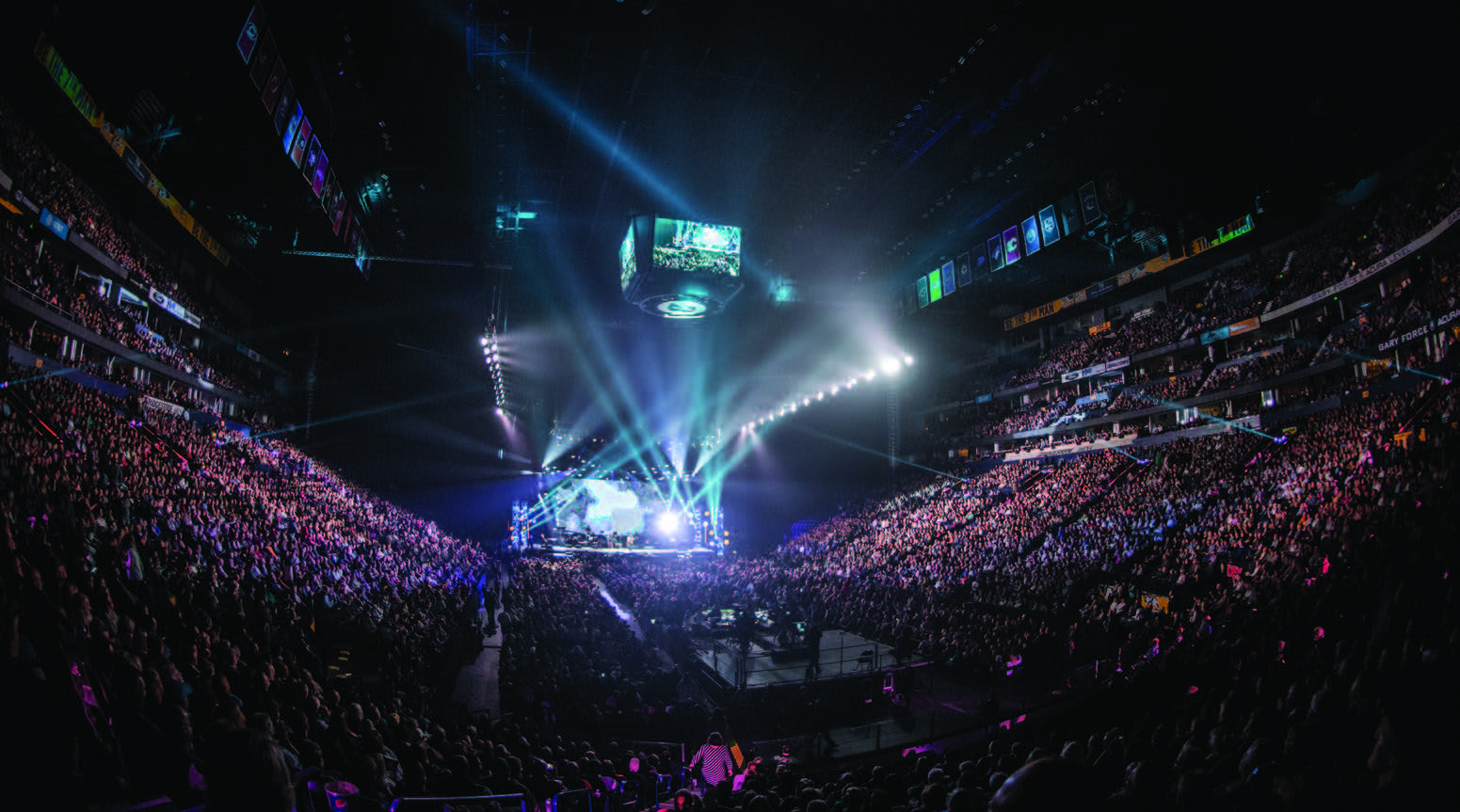
“We had some singers who were right on the mic and others who had the mic a foot from their mouth, barely singing into it,” he continues. “Instead of using EQ on the L/R bus, we used the channel EQ on the PM10. It’s very powerful and precise, and you don’t have to stay with one style of EQ—you have options of aggressive, smooth or precise curves. There’s an 1176 plug-in on each channel of the PM10, and we used that for consistent treatment of every vocal channel.” “Kenny has always had a style where he sings way off axis from the mic,” interjects Bugos, noting that he sang through a wireless Shure SM58. “He’s got a very recognizable quality to his voice, that sort of gravelly thing in the 2kHz region. I have to make sure that the presence is there, along with the warmth and the low end. If you go to a concert to see someone you like, you know the words to most of the songs. I make a big deal about imagining that this is the first time I‘m hearing these songs. These songs are stories. I want to make sure that his voice sounds the way people remember it.”
The band used in-ears for monitoring, but Kenny—not so much. “Kenny is very old-school when it comes to monitors,” reveals Bugos. “He has three sets of ears that we carry with us, and we’ve tried them many times with every trick you can imagine to make him feel comfortable. But Kenny’s show is based upon him entertaining the crowd, interacting with the audience, and talking and listening to them. We’ve never been able to make it work to a point where he can get the response he needs in order to interact with the audience. So he has three sets of stereo wedges across the stage. Fortunately stage volume is relatively low. I think we have one small bass amp up there that’s behind a baffle, so we can give him a good mix from those wedges.”
Most of the show featured the guest artists performing Rogers’ songs, but the most special moments came at the end of the night when Rogers performed with Dolly Parton, possibly for the last time.
“Kenny didn’t sing at all until the end when he and Dolly performed ‘You Can’t Make Old Friends,’” reports Bugos, “and then they closed with ‘Islands in the Stream.’ It was two extremes: ‘You Can’t Make Old Friends’ brought out the tears and the tissues, and ‘Islands in the Stream’ had everybody on their feet going absolutely crazy. When they were finished with ‘You Can’t Make Old Friends,’ they did something I didn’t know about. I don’t think anybody knew. They sat down and told stories about each other, about touring together. It was truly touching. Then they did ‘Islands in the Stream,’ and when they were finished they did the old classic ‘drop the mic, I’m done and I’m outta here!’ John and I made sure that those mics stayed wide open so when they hit the ground it was like Kaboom! It was a fun way to end the night.”
